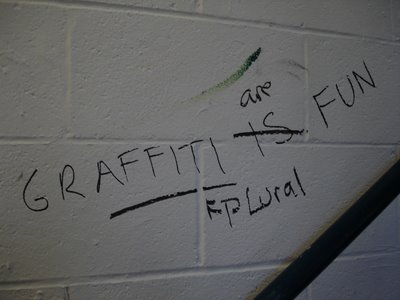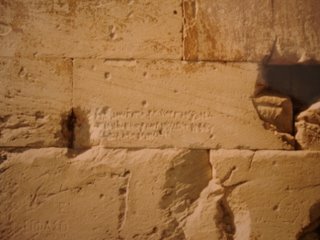Graffiti are fun.
Tonight's post is dually inspired and will be more pictorial than anything. As you know, if you pay attention to what I tell you, I'm particularly fond of a particular blogfriend's way of seeing her world, and a couple of weeks ago, she shared her secret: look down! and sometimes, look up! Now, being more of a look around! person, myself, I've been trying out her advice. And it's funny: I've lived in small towns most of my life, and I really don't cop to the idea that there's nothing much going on in small towns. But there have been times, in the past couple of weeks, when I've wondered whether there's just that much to see if I look up and down on my usual half-mile walk to school.
Well.
Today, no more than ten minutes after I posted my writing for "yesterday," I realized that I'd never taken the time to look at a couple of utility covers that I pass every day. They're a little bit up a hill from the street, so I stepped up the hill, and lo and behold, look what I saw. (Keep in mind what "yesterday"'s post was about.)


Now, that's what I call synergy. Or something.
As I made my way home from the library a little while later (for last-minute research work is ongoing: I am at that stage of a particular project where I am sure that little things are going to make me great; I've been fighting to keep myself in my house for the past hour, because my irrational researcher is simply certain that a handful of pieces from the London Times and Scribner's from late 1928 and early 1929 are going to be crucial; my rational researcher suspects that they will be useful, but not right this second), I took some time to keep photographing trees in various stages of tiny flowering. But I also started picking up a theme I hadn't expected: words and images in unexpected places. For some (fairly obvious) reasons, people have graffitied the backs of a couple of signs leading out of Gambier. These graffiti strike me as simultaneously whimsical and utterly sinister:


The reason I was seeing these graffiti in the first place is that I decided to take a different route home than usual, which in turn led me up to the doors of one of Kenyon's art buildings. I've always loved this building, and one big reason for that love is that the art students have made this stately old brick building, which was originally an Episcopal seminary, into something of an artwork itself. The stairwells are often full of graffiti; student art is everywhere in two upper floors of studio and lab space; the building feels open and available in useful, provocative ways. (I don't mean to romanticize; I know that artists and art professors here are longing for a new building, and I can understand that desire as well.)
So this evening I stepped into Bexley Hall to take a look around and see what's new. And one thing that's new is that the amount of graffiti seems to have plummeted. One of the only legible pieces I saw was in the eastern stairwell (the imperative descends the stairs):

(I don't just love it because it reminds me of those lines from the Beastie Boys' song "Crawlspace": "You better think twice / before you start flossin' / I've been in your bathroom often." But listen when I tell you, dog, that association's not a drawback.)
And on the wall right beside it was this piece:

Now, I have to say that I heart this image a lot. I love that we have at least one kid on campus who would correct a piece of graffiti in the art building--who'd not only recognize the subject/verb agreement error but point it out to others. Yeah, I'll admit it's a little pedantic, but I love it anyway. And I also love that it made me come home (much later) and look up "graffiti" in the dictionary. Indeed, "graffiti" is plural for "graffito" (a word I know from one of the subjects of my dissertation, who described his arousal at seeing an obscene graffito on a wall in London in the 1860s). And graffito, in turn, comes from the Italian "graffio," for "a scratch." (Eventually, I suspect, it all goes back to the Greek verb "graphein," "to write.") Turns out "graffiti" and "graffito" don't enter the English language until the 1850s, and they seem to come into the language as a way to describe scribblings on ancient walls, in particular--scribblings and drawings of the sort that were being turned up in Pompeii and in Rome.
One of my aspirations, when I was studying abroad, was to go through Greece and find all the places where Byron had graffitied his name in the 1810s and 1820s. I know that at least one such place is the Temple of Poseidon, at Sounion (not so far from Athens), and that another is the famous cave on Antiparos, one of the islands that make up the Cyclades. I've not made it to either of those places, and I've never seen where Byron carved his name. But I did get to see terrific graffiti while I was studying in Greece, all the same. Both of these images (which are significantly sharper in the original, by the way) are from the Temple of Hephaestus in the Athenian Agora (just northeast of the Acropolis):


I've always loved the one with the little guy, in particular--probably because those shadow-columns make me feel all over again how blindingly bright the Athenian sun is in July, how deeply bronzed I was when I returned home. But I think I also like the idea that the Greeks--however ancient they were, the ones who carved these things--were also looking up, looking down, trying to catch images of what they saw themselves passing.